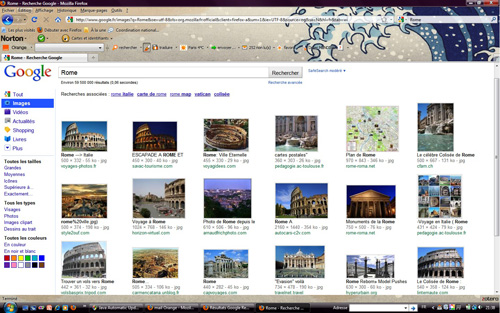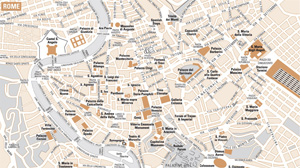1. Rome, memory city
1a. Plan of central Roma
Questions 1a
1b. Search "Rome"
 Click image to enlarge
Click image to enlarge
Source: Screenshot of the query "Rome" by Didier Mendibil, March 3, 2011. Google-images.
Questions 1b
Answers 1a
- The major public monuments that are accessible to tourists in central Rome are depicted in brown. They have been created at different times and dedicated to different functions. The Quirinale Palace is the seat of the Presidency of the Italian Republic, the station Termini is the central station. Ancient sites sometimes recognizable by the presence of ruins (in gray) or by Greek or Latin names (Pantheon, Ara Pacis, Colosseo, Domus Aurea) are mainly located in the loop of the Tiber. It is near the place of crossing by the Tiberina Island that we see the famous hills of the Palatine and the Capitol, covered with ancient ruins as they were the cradle of Roma. . The location of the Coliseum is approximately the center of the Roman capital of the 2nd century AD. The abundance of religious buildings mostly Catholics (there are 18 churches on the plan although we note the existence of a synagogue) is obviously a consequence of the permanency, since Roman times, of the residence of the Christian Popes at the Vatican, that is to say the other side of the Tiber.
- The street grid does not seem to be focused by the attraction of a single center. At most we remark focused areas towards the bridges of Vatican and the Castel Sant Angelo, towards the Poppolo square (located off the north part), Esquilino Square, Venezia Square, Colosseo Square and some heterogeneity in the organization of streets indicating their construction at different times. The area around the station Termini and in Vatican show parallel streets and wide enough to indicate they were built "out of the walls" in the nineteenth century. However, inside the loop of the Tiber, were visibly superimposed several patterns of movement between the Middle Ages and modern times.
- The nomenclature of this plan juxtaposes words in Italian, to describe particularly the streets but also in Latin and English for some monuments.
Analysis of street names shows they mix geographical references (Venezia Square, Milano Street, Palermo Street, Piemonte Street, Sicilia Street), references to the Fatherland and politicians who constructed the unification of Italy (Nazionale, Repubblica, Cavour, Crispi, Vittorio Emanuele, Garibaldi) and historical references (Risorgimento Square, Rinascimento Walk, 20 September Street), etc. In short, the entire national memory whose places of the capital provide a permanent memorial are the open book of history as for all the streets of all European cities. - This question aims to summarize the comments made in response to previous questions and to highlight the historical dimension of the great cities of Europe and, in particular, of a city like Roma, but also, more generally, to emphasize the memorial references they are responsible to maintain in the urban anchorage of national cultures like Rome gives a good example here. We invite students to compare the Roman case with the center of another city they know.
Answers 1b
- Over 80% of the 18 images most associated with the word "Rome" by the Google search engine are monuments and 20% indirectly represent a monument indirectly, that is to say by a map or a postcard. The most famous of all Roman monuments is the Coliseum because alone it is represented as often as St. Peter's Basilica, the Roman Forum and Trevie Fountain together. The strong iconic power of the Coliseum is due to the impressive size and the suggestiveness of the ruins, the evocation of a people assembled for the Games and the cruelty of the scenes that took place in it. Saint-Pierre symbolizes the pinnacle of the Christian institution and it is the destination of the pilgrimages to Roma. The Trevie Fountain has enjoyed a period of a beautiful film promotion. Few cities can offer such a wide range of famous places, but for every city we can verify the impact of tourist celebrity of certain places.
- This question seeks to identify the mainly French origin of these representations of the city of "Rome": hence the importance of monumental iconography and tourist points of view. It is easy to verify by the same way that the inhabitants of Rome have not so stereotypical and historic representation of their capital "Roma" even if the share of monuments and even the Coliseum remain significant in the images associated to this name. Most noticeable was that the eruption of evocative images of a famous football club of the same name ("Roma") is very different from the representation of the French public.




